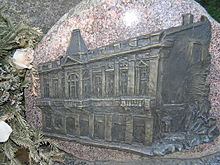Michler's Palace

Michler Palace (Polish: Pałacyk Michlera, Pałacyk Michla) was a townhouse in Warsaw located at Wolska Street no 40 in the Wola district. It was constructed in the late 19th century and destroyed during the Warsaw Uprising in 1944. It is known for an eponymous wartime song, Pałacyk Michla, which was written by poet and insurgent Józef Szczepański.[1][2]
History
[edit]The term palace is colloquial, and the building was a townhouse (built in the eclecticism style) rather than formally a palace.[2][3] It was nicknamed in such a way because it stood out as a high quality, decorative construction amidst its more mundane surroundings.[3] The building belonged to Karol Michler, a merchant, miller and entrepreneur, who also had a small food factory in its vicinity, producing pasta and bread.[3] The factory was taken over by Nazi Germany following their invasion of Poland in 1939.[3]
During the Warsaw Uprising of 1944, the building was the site of intense fighting around August 4 and 5 involving the Parasol Battalion insurgent unit.[2] Insurgent poet Józef Szczepański, a member of the Parasol unit,[4] wrote a song (Pałacyk Michla) about those events, performing it in its vicinity on the evening of August 4.[3][5] The song, published shortly afterward in an insurgent newspaper, quickly taken up by the partisans, was performed for them by a popular singer Mieczysław Fogg, and later, became known across Poland.[3][6][7] On the next day the Germans captured the building, which, damaged in the fighting, was demolished shortly after.[2] The song has been called Szczepański's most famous song,[7] and its tune was based on an earlier, pre-war song by the Slovak composer Jan Šťastný.[7][8][9]
In 2007, a monument commemorating the building and the fighting that took place during the Uprising was unveiled near the building's former location on Wolska Street.[3]
See also
[edit]References
[edit]- ^ Rodak, Wojciech (2019-08-01). "Śladami Powstania '44. Pałacyk Michla. Legendarna reduta "Gryfa" na Wolskiej 40". Portal I.pl (in Polish). Retrieved 2019-11-13.
- ^ a b c d Czechowski, Paweł. "Pałacyk Michla: bohaterski opór oddziału "Gryfa"". Histmag (in Polish). Retrieved 2019-11-13.
- ^ a b c d e f g Majewski, Jerzy S. (10 May 2007). "Od pałacyku Michla na Kercelak". Gazeta Wyborcza (in Polish). Retrieved 2019-11-13.
- ^ Michael Moran (2 June 2011). A Country In The Moon: Travels In Search Of The Heart Of Poland. Granta Publications. p. 44. ISBN 978-1-84708-493-4.
- ^ Majewski, Jerzy S. (31 July 2013). "O czym naprawdę jest najpopularniejsza powstańcza piosenka?". wyborcza.pl (in Polish). Retrieved 2019-11-15.
- ^ "World War 2: Warsaw Uprising :: Songs". www.warsawuprising.com. Retrieved 2019-11-15.
- ^ a b c Redakcja (2008-08-01). "Bard "Parasola"". Dziennik Polski (in Polish). Retrieved 2019-11-15.
- ^ Robert Allen Rothstein (2008). Two Words to the Wise: Reflections on Polish Language, Literature, and Folklore. Slavica Publishers. p. 15. ISBN 978-0-89357-361-4.
- ^ Łobodziński, Filip (21 August 2005). "Rosną czy runą". www.newsweek.pl (in Polish). Retrieved 2019-11-15.
